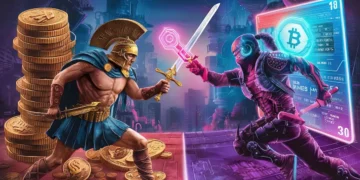After months of market stagnation, NFTs appear to be turning a corner. July brought a decisive shift in momentum—NFT trading volume, average sale price, and overall market cap all surged, with blue-chip collections at the forefront. But this isn’t just a technical bounce.
The latest data signals a deeper rotation: one away from speculative churn and toward scarcity, storytelling, and brand credibility.
Quick Snapshot: July’s NFT Performance
According to DappRadar, the NFT market had its strongest month since February:
-
Market cap rose 94% to $6.6 billion—the highest level of 2025 so far.
-
Weekly trading volume spiked 51%, reaching $136 million.
-
The average NFT price jumped 40% in just seven days, hitting $146.
-
Sales count, by contrast, increased only 7% week-over-week.
This divergence tells a bigger story. The market is entering a quality-over-quantity phase, where scarcity and cultural value are driving more volume than sheer transaction count. Traders are consolidating into premium assets, avoiding flips in favor of brand equity.
What’s Fueling the Rebound?
The resurgence isn’t being led by tokenomics gimmicks or staking incentives. Instead, capital is flowing into projects with long-term presence, strong digital identity, and mainstream recognizability. In this cycle, credibility may be replacing novelty as the top filter.
Ethereum made a strong comeback in July, climbing over 40% on the back of record-breaking institutional inflows. As ETH regains its place at the center of the crypto conversation, blue-chip NFTs—many of which are built on Ethereum—are starting to attract fresh interest from collectors and institutions alike. While the NFT rally isn’t just about rising crypto prices, the renewed confidence in ETH is clearly helping to lift sentiment around premium digital collectibles.
Profile picture NFTs (PFPs) once again led trading activity, reinforcing their historic dominance during market upswings. Real-world asset NFTs followed closely, highlighting growing interest in tokenized tangible goods. Gaming NFTs, which saw momentum in Q2, showed signs of cooling.
Top Performing Collections
Pudgy Penguins: From Underdog to Market Force
Pudgy Penguins officially overtook Bored Ape Yacht Club (BAYC) in market cap, now second only to CryptoPunks. Their floor price has risen over 60% this month, reaching as high as 18 ETH before settling near 15.8 ETH.
This wasn’t luck. Pudgy Penguins’ bear-market strategy—expanding into retail toys, bridging Web2–Web3 culture, and investing in community visibility—positioned them for this moment. Their trajectory underscores a broader shift: “utility” today looks more like storytelling, brand expansion, and cultural visibility than staking rewards or gated tokens.
CryptoPunks: Digital Status Redefined
CryptoPunks staged a powerful comeback, with floor prices jumping 53% to just over $200,000—their highest level since March 2024. A single $4.3 million sweep by an anonymous buyer triggered renewed institutional interest and cultural buzz. Weekly trading volume surged to $24.6 million, up 416%.
Beeple commemorated the moment with his “BIG SWEEP” artwork, and BitMEX co-founder Arthur Hayes captured the sentiment, predicting: “CryptoPunks will outperform $ETH this cycle… it’s an internet status game.” Despite offering no functional utility, Punks are thriving as a pure signal of digital clout.
Moonbirds Momentum
Moonbirds staged a surprising comeback this month, with the floor price rising more than 200%—from under 0.8 ETH to a peak of nearly 2.9 ETH—before settling around 2.3 ETH.
New perks include private on-chain access and boosted airdrop eligibility.
Still, the floor remains 94% below the all-time high, suggesting the comeback has legs—but also a long climb ahead.
Historical Echoes
This isn’t the first NFT rebound. In early 2021 and again in 2023, spikes in Ethereum prices helped fuel sharp jumps in NFT volumes, often led by PFPs and art projects. But those cycles were more speculative and short-lived. July’s bounce feels more deliberate, with traders consolidating around known brands and long-term players.
From Bounce to Recalibration
July’s surge marks more than a market bounce—it could be a recalibration of what holds value in Web3. Instead of chasing quick flips or inflated promises, traders are rewarding collections with cultural durability and consistent storytelling.
Part of what’s driving this recalibration is a shift in user psychology. In bear markets, narratives splinter—value gets abstract, and utility projects often overpromise. But as sentiment improves, collectors lean toward digital assets that offer social certainty: brand, status, and cultural weight.
NFTs are becoming less about what they do and more about what they signal. Identity is the new utility, and reputation is quickly becoming the asset class. I’ve seen this shift play out firsthand in the way traders now talk about value—not in features, but in presence.
If this rotation holds, it could redefine the term “utility” for NFTs. The most successful projects may not be the ones offering features, but those offering identity, emotional resonance, and visible alignment within digital culture.
The next test? Whether mid-tier collections can ride this wave or get swept aside in a market that now prizes clarity, quality, and credibility above all.
After months of market stagnation, NFTs appear to be turning a corner. July brought a decisive shift in momentum—NFT trading volume, average sale price, and overall market cap all surged, with blue-chip collections at the forefront. But this isn’t just a technical bounce.
The latest data signals a deeper rotation: one away from speculative churn and toward scarcity, storytelling, and brand credibility.
Quick Snapshot: July’s NFT Performance
According to DappRadar, the NFT market had its strongest month since February:
-
Market cap rose 94% to $6.6 billion—the highest level of 2025 so far.
-
Weekly trading volume spiked 51%, reaching $136 million.
-
The average NFT price jumped 40% in just seven days, hitting $146.
-
Sales count, by contrast, increased only 7% week-over-week.
This divergence tells a bigger story. The market is entering a quality-over-quantity phase, where scarcity and cultural value are driving more volume than sheer transaction count. Traders are consolidating into premium assets, avoiding flips in favor of brand equity.
What’s Fueling the Rebound?
The resurgence isn’t being led by tokenomics gimmicks or staking incentives. Instead, capital is flowing into projects with long-term presence, strong digital identity, and mainstream recognizability. In this cycle, credibility may be replacing novelty as the top filter.
Ethereum made a strong comeback in July, climbing over 40% on the back of record-breaking institutional inflows. As ETH regains its place at the center of the crypto conversation, blue-chip NFTs—many of which are built on Ethereum—are starting to attract fresh interest from collectors and institutions alike. While the NFT rally isn’t just about rising crypto prices, the renewed confidence in ETH is clearly helping to lift sentiment around premium digital collectibles.
Profile picture NFTs (PFPs) once again led trading activity, reinforcing their historic dominance during market upswings. Real-world asset NFTs followed closely, highlighting growing interest in tokenized tangible goods. Gaming NFTs, which saw momentum in Q2, showed signs of cooling.
Top Performing Collections
Pudgy Penguins: From Underdog to Market Force
Pudgy Penguins officially overtook Bored Ape Yacht Club (BAYC) in market cap, now second only to CryptoPunks. Their floor price has risen over 60% this month, reaching as high as 18 ETH before settling near 15.8 ETH.
This wasn’t luck. Pudgy Penguins’ bear-market strategy—expanding into retail toys, bridging Web2–Web3 culture, and investing in community visibility—positioned them for this moment. Their trajectory underscores a broader shift: “utility” today looks more like storytelling, brand expansion, and cultural visibility than staking rewards or gated tokens.
CryptoPunks: Digital Status Redefined
CryptoPunks staged a powerful comeback, with floor prices jumping 53% to just over $200,000—their highest level since March 2024. A single $4.3 million sweep by an anonymous buyer triggered renewed institutional interest and cultural buzz. Weekly trading volume surged to $24.6 million, up 416%.
Beeple commemorated the moment with his “BIG SWEEP” artwork, and BitMEX co-founder Arthur Hayes captured the sentiment, predicting: “CryptoPunks will outperform $ETH this cycle… it’s an internet status game.” Despite offering no functional utility, Punks are thriving as a pure signal of digital clout.
Moonbirds Momentum
Moonbirds staged a surprising comeback this month, with the floor price rising more than 200%—from under 0.8 ETH to a peak of nearly 2.9 ETH—before settling around 2.3 ETH.
New perks include private on-chain access and boosted airdrop eligibility.
Still, the floor remains 94% below the all-time high, suggesting the comeback has legs—but also a long climb ahead.
Historical Echoes
This isn’t the first NFT rebound. In early 2021 and again in 2023, spikes in Ethereum prices helped fuel sharp jumps in NFT volumes, often led by PFPs and art projects. But those cycles were more speculative and short-lived. July’s bounce feels more deliberate, with traders consolidating around known brands and long-term players.
From Bounce to Recalibration
July’s surge marks more than a market bounce—it could be a recalibration of what holds value in Web3. Instead of chasing quick flips or inflated promises, traders are rewarding collections with cultural durability and consistent storytelling.
Part of what’s driving this recalibration is a shift in user psychology. In bear markets, narratives splinter—value gets abstract, and utility projects often overpromise. But as sentiment improves, collectors lean toward digital assets that offer social certainty: brand, status, and cultural weight.
NFTs are becoming less about what they do and more about what they signal. Identity is the new utility, and reputation is quickly becoming the asset class. I’ve seen this shift play out firsthand in the way traders now talk about value—not in features, but in presence.
If this rotation holds, it could redefine the term “utility” for NFTs. The most successful projects may not be the ones offering features, but those offering identity, emotional resonance, and visible alignment within digital culture.
The next test? Whether mid-tier collections can ride this wave or get swept aside in a market that now prizes clarity, quality, and credibility above all.




















































































![Ethereum [ETH] could stumble near $2000 despite bullish momentum, here’s why](https://coininsights.com/wp-content/uploads/2023/04/PP-3-ETH-price.png)